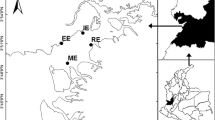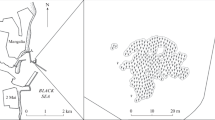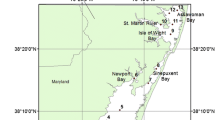Abstract
The mercury bioaccumulation and population dynamics of the mysid Mesopodopsis slabberi was assessed along a mercury gradient in Ria de Aveiro (Portugal). M. slabberi is one of the most important mysid species in European temperate coastal shallow waters playing a key ecological role. Nevertheless, no references were found concerning the possible consequences of the Hg on the trophodynamics of these coastal ecosystems. M. slabberi showed a clear bioaccumulation along the Hg gradient and through life, with mature females reaching the highest concentrations. In terms of population structure, higher densities and biomasses of M. slabberi were assessed in the most contaminated areas contrarily to the least polluted areas. Despite the mercury accumulation in its tissues no strong negative effects on the structure and population dynamics of the species were observed. However, mysids might be important in the transfer of metals from the sediments and zooplankton to higher trophic levels such as fishes, most of them with commercial interest.









Similar content being viewed by others
References
Azeiteiro UMM, Jesus L, Marques JC (1999) Distribution, population dynamics and production of the suprabenthic mysid Mesopodopsis slabberi van Beneden in the Mondego estuary (western coast of Portugal). J Crustacean Biol 19(3):498–509
Bignert A, Cossa D, Emmerson R, Fryer R, Füll C, Fumega J, Laane R, Calls HM, McHugh B, Miller B, Millward G, Moffat C, Pijnenburg J, Roose P, Ruus A, Schmolke S, Smedes F, Strand J, Stronkhorst J, Thain J, Tissier C, Traas T, Tronczynski J (2004) OSPAR/ICES workshop on the evaluation and update of background reference concentrations (B/RCs) and ecotoxicological assessment criteria (EACs) and how these assessment tools should be used in assessing contaminants in water, sediments and biota. Final report to OSPAR Commission, The Hague, pp 92–96. Retrieved 20 October 2009 from http://www.ospar.org/documents/dbase/publications/p00214_BRC%20EAC%20Workshop.pdf
Bu-Olayan AH, Mohammed HMA, Subrahmanyam MNV, Thomas BV (1998) Effect of size upon metal content of lobster (Thenus orientalis) from the Kuwait marine environment. Bull Environ Contam Toxicol 61:175–181
Cardoso PG, Brandão A, Pardal MA, Raffaelli D, Marques JC (2005) Resilience of Hydrobia ulvae populations to anthropogenic and natural disturbances. Mar Ecol Prog Ser 289:191–199
Cardoso PG, Sousa E, Matos P, Henriques B, Pereira E, Duarte AC, Pardal MA (2013) Impact of mercury contamination on the population dynamics of Peringia ulvae (Gastropoda): implications on metal transfer through the trophic web. Estuar Coast Shelf S. doi:10.1016/j.ecss.2013.06.002
Cockcroft AC, Webb P, Wooldridge T (1988) Nitrogen regeneration by two surf-zone mysids, Mesopodopsis slabberi and Gastrosaccus psammodytes. Mar Biol 99:75–82
Coelho JP, Pereira ME, Duarte A, Pardal MA (2005) Macroalgae response to a mercury contamination gradient in a temperate coastal lagoon (Ria de Aveiro, Portugal). Estuar Coast Shelf S 65:492–500
Coelho JP, Rosa M, Pereira E, Duarte A, Pardal MA (2006) Pattern and annual rates of Scrobicularia plana mercury bioaccumulation in a human induced mercury gradient (Ria de Aveiro, Portugal). Estuar Coast Shelf S 69:629–635
Coelho JP, Policarpo E, Pardal MA, Millward GE, Pereira ME, Duarte AC (2007) Mercury contamination in invertebrate biota in a temperate coastal lagoon (Ria de Aveiro, Portugual). Mar Pollut Bull 54:475–480
Council Directive 82/176/EEC on limit values and quality objectives for mercury discharges by the chlor-alkali electrolysis industry, 22 March 1982
Dauvin JC (1986) Dynamique de la population d’Abra prismatica (Mollusque, Bivalve) de la baie de Morlaix (manche occidentale). Ann I Oceanogr Paris 62(1):1–12
Delgado L, Guerao G, Ribera C (1997) Biology of the mysid Mesopodopsis slabberi (van Beneden, 1861) (Crustacea, Mysidacea) in a coastal lagoon of the Ebro delta (NW Mediterranean). Hydrobiologia 357:27–35
Drava G, Capelli R, Minganti V, Pellegrini RD, Relini LO, Ivaldi M (2004) Trace elements in the muscle of red shrimp Aristeus antennatus (Risso, 1816) from Ligurian Sea (NW Mediterranean): variations related to the reproductive cycle. Sci Total Environ 321:87–92
Elahi M, Esmaili-Sari A, Bahramifar N (2012) Total mercury levels in selected tissues of some marine Crustaceans from persian gulf, Iran: variations related to length, weight and sex. Bull Environ Contam Toxicol 88:60–64
Fanelli E, Cartes JE, Badalamenti F, Rumolo P, Sprovieri M (2009) Trophodynamics of suprabenthic fauna on coastal muddy bottoms of the southern Tyrrhenian sea (western mediterranean). J Sea Res 61:174–187
Fockedey N, Mees J (1999) Feeding of the hyperbenthic mysid Neomysis integer in the maximum turbidity zone of the Elbe, Westerschelde and Gironde estuaries. J Marine Syst 22:207–228
Gayanilo FC, Pauly D (1997) FAO-ICLARM stock assessment tools (FISAT), reference manual. FAO computerized information series (Fisheries) No. 8, FAO, Rome, p 262
Gentile SM, Gentile JH, Walker J, Heltshe JF (1982) Chronic effects of cadmium on two species of mysid shrimp: Mysidopsis bahia and Mysidopsis bigelowi. Hydrobiologia 93:195–204
González-Ortegón E, Drake P (2012) Effects of freshwater inputs on the lower trophic levels of a temperate estuary: physical, physiological or trophic forcing? Aquat Sci 74(3):455–469
Granda LD, Fockedey N, De Mey M, Beyst B, Cornejo MP, Calderon J, Vincx M (2004) Spatial patterns of the surf zone hyperbenthic fauna of Valdivia Bay (Ecuador). Hydrobiologia 529:205–224
Kennish MJ (2002) Environmental threats and environmental futures of estuaries. Environ Conserv 29(1):78–107
Kestrup ǺM, Ricciardi A (2008) Occurrence of the Ponto-Caspian mysid shrimp Hemimysis anomala (Crustacea, Mysida) in the St. Lawrence River. Aquat Invas 3:461–464
Laane RWPM (ed.) (1992) Background concentrations of natural compounds in rivers, sea water, atmosphere and mussels. Tidal waters division, Report DGW-92.033, pp 27–39
Lasenby DC, Van Duyn J (1992) Zinc and cadmium accumulation by the opossum shrimp Mysis relicta. Arch Environ Toxicol 23:179–183
Mason RP, Reinfelder JR, Morel MM (1995) Bioaccumulation of mercury and methylmercury. Water Air Soil Poll 80(1–4):915–921
Minganti V, Capelli R, De Pellegrini R, Relini LO, Relini G (1996) Total and organic mercury concentrations in offshore crustaceans of the Ligurian sea and their relations to the trophic levels. Sci Total Environ 184:149–162
Mucci A, Lucotte M, Montgomery S, Plourde Y, Pichet P, Tra HV (1995) Mercury remobilization from flooded soils in a hydroelectric reservoir of northern Quebec, La Grande-2: results of a soil resuspension experiment. Can J Fish Aquat Sci 52:2507–2517
Nunes M, Coelho JP, Cardoso PG, Pereira ME, Duarte AC, Pardal MA (2008) The macrobenthic community along a mercury contamination in a temperate estuarine system (Ria de Aveiro, Portugal). Sci Total Environ 405:186–194
Pato P, Lopes C, Válega M, Lillebø AI, Dias JM, Pereira E, Duarte A (2008) Mercury fluxes between a coastal lagoon (Ria de Aveiro, Portugal) and the Atlantic ocean. Estuar Coast Shelf Sci 76:787–796
Pereira ME, Abreu SN, Coelho JP, Lopes CB, Pardal MA, Vale C, Duarte AC (2006) Seasonal fluctuations of tissue mercury contents in the European shore crab Carcinus maenas from low and high contaminations areas (Ria de Aveiro, Portugal). Mar Pollut Bull 52:1450–1457
Pereira ME, Lillebø AI, Pato P, Válega M, Coelho JP, Lopes CB, Rodrigues S, Cachada A, Otero M, Pardal MA, Duarte AC (2009) Mercury pollution in Ria de Aveiro (Portugal): a review of the system assessment. Environ Monit Assess 155:39–49
Pérez S, Beiras R (2010) The mysid Siriella armata as a model organism in marine ecotoxicology: comparative acute toxicity sensitivity with Daphnia magna. Ecotoxicology 19:196–206
Rappé K, Fockedey N, Van Colen C, Cattrijsse A, Mees J, Vincx M (2011) Spatial distribution and general population characteristics of mysid shrimps in the Westerschelde estuary (SW Netherlands). Estuar Coast Shelf 91:187–197
Remerie T, Bourgois T, Pealaers D, Vierstraete A, Vanfleteren J, Vanreusel A (2006) Phylogeographic patterns of the mysid M. slabberi (Crustacea, Mysida) in Western Europe: evidence for high molecular diversity and cryptic speciation. Mar Biol 149:465–481
Roast SD, Widdows J, Jones MB (2000) Mysids and trace metals: disruption of swimming as a behavioural indicator of environmental contamination. Mar Environ Res 50:107–112
Sardo AM, Morgado F, Soares AMVM (2005) Mesopodopsis slabberi (Crustacea: Mysidacea): can it be used in toxicity tests? Ecotox Environ Safe 60:81–86
Verslycke T, Vangheluwe M, Heijerick D, De Schamphelaere K, Van Sprang P, Janssen CR (2003) The toxicity of metal mixtures to the estuarine mysid Neomysis integer (Crustacea: Mysidacea) under changing salinity. Aquat Toxicol 64:307–315
Vilas C, Drake P, Pascual E (2009) Inter- and intra-specific differences in euryhalinity determine the spatial distribution of mysids in a temperate European estuary. J Exp Mar Biol Ecol 369:165–176
Webb P, Wooldridge TH (1990) Die1 horizontal migration of Mesopodopsis slabberi (Crustacea: Mysidacea) in Algoa Bay, southern Africa. Mar Ecol Prog Ser 62:73–77
Zar J (1996) Biostatistical Analysis, 3rd edn. Prentice-Hall, Upper Saddle River
Acknowledgments
This work was supported by FCT (Fundação para a Ciência e Tecnologia) through a project n. FCOMP-01-0124-FEDER-010598 (MERCOAST, Refª. FCT PTDC/MAR/101906/2008) and by POPH and QREN—Promotion of scientific job funded by European social fund and national funds of MEC. The authors are indebted to all the colleagues that assisted in the field and lab work.
Conflict of interest
The authors declare that they have no conflict of interest.
Author information
Authors and Affiliations
Corresponding author
Rights and permissions
About this article
Cite this article
D’Ambrosio, M., Marques, S.C., Azeiteiro, U.M. et al. Mercury bioaccumulation and the population dynamics of Mesopodopsis slabberi (Crustacea: Mysidacea) along a mercury contamination gradient. Ecotoxicology 22, 1278–1288 (2013). https://doi.org/10.1007/s10646-013-1115-4
Accepted:
Published:
Issue Date:
DOI: https://doi.org/10.1007/s10646-013-1115-4




